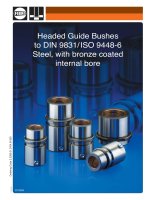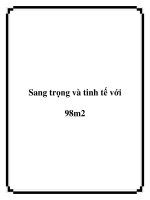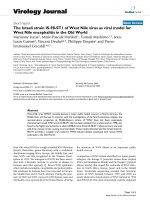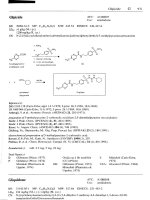C940 98
Bạn đang xem bản rút gọn của tài liệu. Xem và tải ngay bản đầy đủ của tài liệu tại đây (22.77 KB, 2 trang )
Designation: C 940 – 98a
Standard Test Method for
Expansion and Bleeding of Freshly Mixed Grouts for
Preplaced-Aggregate Concrete in the Laboratory1
This standard is issued under the fixed designation C 940; the number immediately following the designation indicates the year of
original adoption or, in the case of revision, the year of last revision. A number in parentheses indicates the year of last reapproval. A
superscript epsilon (e) indicates an editorial change since the last revision or reapproval.
5. Significance and Use
5.1 This method is useful for determining the expansion and
bleeding characteristics of freshly mixed fluid grout used in PA
concrete.
1. Scope
1.1 This test method determines the amount of expansion
and accumulation of bleed water at the surface of freshly mixed
hydraulic-cement grout used in the production of preplacedaggregate (PA) concrete.
1.2 It is for use with cement grout whether or not it includes
fine aggregate or mineral admixtures or both.
1.3 The values stated in SI units are to be regarded as
standard.
1.4 This standard may involve hazardous materials, operations, and equipment. This standard does not purport to
address all of the safety concerns, if any, associated with its
use. It is the responsibility of the user of this standard to
establish appropriate safety and health practices and determine the applicability of regulatory limitations prior to use.
6. Interferences
6.1 Failure to obtain a uniformly smooth mixture, free of
lumps, will cause excessive bleeding and may result in reduced
expansion.
6.2 The capability of most admixtures to produce expansion
and the tendency to bleed is related to the temperature of the
grout during the period of test.
7. Apparatus
7.1 Glass Graduate, 1000 mL, reading to 10 mL.
7.2 Glass Graduate, 25 mL, reading to 1 mL.
7.3 Thermometer, accurate to 0.5°C (1°F) for measuring
grout and air temperature.
2. Referenced Documents
2.1 ASTM Standards:
C 125 Terminology Relating to Concrete and Concrete
Aggregates2
C 937 Specification for Grout Fluidifier for PreplacedAggregate Concrete2
8. Test Sample
8.1 The grout test sample shall consist of approximately
1500 mL and shall be representative of the grout in the mixer.
9. Procedure
9.1 When sampling and testing are being performed in the
laboratory for the purpose of designing or comparing mixtures
or for qualifying admixtures including grout fluidifiers proceed
in the following manner:
9.1.1 Maintain the ambient temperature of the room in
which the test is performed at 23.0 6 2°C (73.4 6 3°F), unless
otherwise specified.
9.1.2 Bring the temperature of all dry materials and mixing
water to a constant temperature of 23.0 6 2°C (73.4 6 3°F)
before mixing, unless otherwise specified.
9.1.3 Start volume measurements within 3 min of completion of mixing.
9.2 When sampling and testing are being performed in the
field, record the temperature of the grout sample and the
ambient temperature of the area in which the test readings are
made. Record the time interval between completion of mixing
and start of test.
9.3 Immediately after the completion of mixing, measure
the temperature of the grout. Then introduce the grout into a
3. Terminology
3.1 Definition of Terms—Terms used in this test method are
defined in Terminology C 125 or in this section.
3.1.1 expansion—increase in the volume of a grout, expressed as a percentage of the original volume of the grout.
3.1.2 bleeding—This term is defined as stated in Terminology C 125, with the exception that it pertains to grout in this
test method.
4. Summary of Test Method
4.1 Grout is placed in a graduated cylinder. Changes in total
volume and accumulation of bleed water, if any, on the surface
of the grout are observed over a period of time.
1
This test method is under the jurisdiction of ASTM Committee C-9 on Concrete
and Concrete Aggregates and is the direct responsibility of Subcommittee C09.41 on
Concrete for Radiation Shielding.
Current edition approved May 10, 1998. Published December 1998. Originally
published as C 940 – 81. Last previous edition C 940 – 98.
2
Annual Book of ASTM Standards, Vol 04.02.
Copyright © ASTM, 100 Barr Harbor Drive, West Conshohocken, PA 19428-2959, United States.
1
C 940
Vw 5 volume of decanted bleed water, mL.
1000-mL graduated cylinder until the volume of the sample is
800 6 10 mL. Record the volume of the sample and the time
at which the reading was made. Place the graduated cylinder on
a level surface free of vibration. Cover to prevent evaporation
of the bleed water.
9.4 Take and record the readings, estimated to the nearest 1
mL, of the upper surfaces of the grout and bleed water, if any,
of the sample in the graduate at 15-min intervals for the first 60
min and thereafter at hourly intervals until two successive
readings show no further expansion or bleeding. When the test
for expansion and bleeding is used in connection with Specification C 937, it shall be discontinued 3 h after the initial
reading.
9.5 At the conclusion of the test, decant the bleed water into
a 25-mL graduate by tilting the specimen and drawing the
water off with a pipet or large medicine dropper. Record the
final volume of bleed water to the nearest 0.5 mL.
11. Report
11.1 The report shall include the following:
11.1.1 Identification of the grout sample.
11.1.2 Expansion of grout to the nearest 0.2 % for each
prescribed interval.
11.1.3 Bleeding of grout to the nearest 0.2 % for each
prescribed interval.
11.1.4 Combined expansion of grout plus bleed water to the
nearest 0.2 % for each prescribed interval.
11.1.5 Final bleeding to nearest 0.2 %.
11.1.6 Temperature of grout sample at start of test.
11.1.7 Ambient temperature of laboratory or testing area at
the beginning and end of test.
10. Calculation
10.1 Calculate the expansion of the grout, and its bleeding
and the combined expansion of grout plus bleed water as
percentages of the initial volume of the grout, as follows:
12. Precision and Bias
12.1 Precision:
12.1.1 Bleeding—The single laboratory, three operators,
standard deviation has been found to be 0.06 %. Therefore,
results from two properly conducted tests (by the same
operator) on the same material should not differ by more than
0.17 %.
12.1.2 Combined Expansion—The single laboratory, three
operators, standard deviation has been found to be 0.37 %.
Therefore, results from two properly conducted tests (by the
same operator) on the same material should not differ by more
than 1.04 %.
12.2 Bias—No statements on bias can be prepared because
there are no standard reference materials.
Vg2V1
Expansion, %5 V 3100
1
V22Vg
Bleeding, %5 V 3100 at prescribed intervals
1
V22V1
Combined Expansion, %5 V 3100
1
Vw
Final bleeding, %5 V 3100
1
where:
V1 5 volume of sample at beginning of test, mL,
V2 5 volume of sample at prescribed intervals, measured
at upper surface of water layer, mL,
Vg 5 volume of grout portion of sample at prescribed
intervals, at upper surface of grout, mL, and
13. Keywords
13.1 bleeding; concrete; expansion; grouts; preplacedaggregate; preplaced-aggregate concrete
The American Society for Testing and Materials takes no position respecting the validity of any patent rights asserted in connection
with any item mentioned in this standard. Users of this standard are expressly advised that determination of the validity of any such
patent rights, and the risk of infringement of such rights, are entirely their own responsibility.
This standard is subject to revision at any time by the responsible technical committee and must be reviewed every five years and
if not revised, either reapproved or withdrawn. Your comments are invited either for revision of this standard or for additional standards
and should be addressed to ASTM Headquarters. Your comments will receive careful consideration at a meeting of the responsible
technical committee, which you may attend. If you feel that your comments have not received a fair hearing you should make your
views known to the ASTM Committee on Standards, at the address shown below.
This standard is copyrighted by ASTM, 100 Barr Harbor Drive, PO Box C700, West Conshohocken, PA 19428-2959, United States.
Individual reprints (single or multiple copies) of this standard may be obtained by contacting ASTM at the above address or at
610-832-9585 (phone), 610-832-9555 (fax), or (e-mail); or through the ASTM website (www.astm.org).
2









